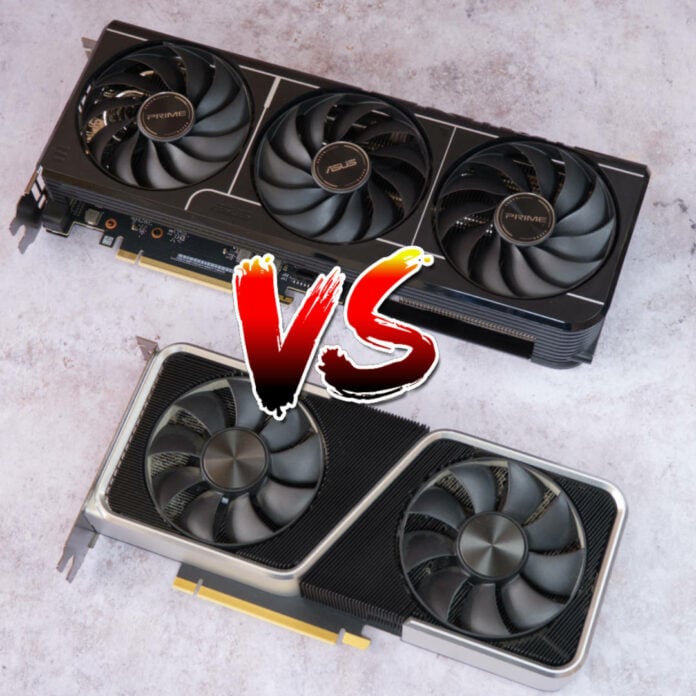Generation after generation, Nvidia’s 60 Ti Series remains a key battleground for mainstream PC gamers. With almost four and a half years separating the launches of RTX 3060 Ti and RTX 5060 Ti, it’s no surprise the contrast between Ampere and Blackwell is stark, but the newcomer has big shoes to fill given the sheer popularity of its predecessor’s value proposition.
Although RTX 3060 Ti relied on brute force and a wide memory bus, RTX 5060 Ti takes a more efficient path to achieve its frame rates, delivering generational gains through tighter design, faster clocks, and advanced AI features like DLSS 4. It’s a shift in philosophy as much as performance, marking the inevitable march of both time and technology, but you’re better seeing it to believe it.
Specs
At a glance, RTX 3060 Ti might seem beefier. It has more CUDA cores (4,864 vs. 4,608), a wider memory bus, more ROPs, and even a larger die built using Samsung’s older 8nm process. But these figures mask the true gains of Nvidia’s new 4nm Blackwell architecture.
| RTX 5060 Ti | RTX 3060 Ti | Ratio | |
|---|---|---|---|
| Released | Apr 2025 | Dec 2020 | – |
| Codename | Blackwell | Ampere | – |
| GPU | GB206 | GA104 | – |
| Process | TSMC 4N (4nm) | Samsung 8N (8nm) | – |
| Transistors | 21.9bn | 17.4bn | 1.26 |
| Die size | 181mm² | 392mm² | 0.46 |
| CUDA cores | 4,608 | 4,864 | 0.95 |
| Boost clock | 2.57GHz | 1.67GHz | 1.54 |
| FP32 Boost TFLOPS | 24 | 16 | 1.50 |
| SM count | 36 of 36 | 38 of 48 | 0.95 |
| RT cores | 36 (4th Gen) | 38 (2nd Gen) | 0.95 |
| RT TFLOPS | 72 | 40 | 1.80 |
| Tensor cores | 144 (5th Gen) | 152 (3rd Gen) | 0.95 |
| ROPs | 48 | 80 | 0.60 |
| Memory | 16GB / 8GB | 8GB | 2.00 / 1.00 |
| Memory type | GDDR7 | GDDR6 | – |
| Memory clock | 28Gb/s | 14Gb/s | 2.00 |
| Memory interface | 128-bit (PCIe 5.0 x8) | 256-bit (PCIe 4.0 x16) | 0.50 |
| Memory bandwidth | 448GB/s | 448GB/s | 1.00 |
| Board power | 180W | 200W | 0.90 |
| Launch MSRP | $379 / $429 | $399 | 0.95 / 1.08 |
Despite having fewer transistors (17.4bn vs. 21.9bn), RTX 3060 Ti occupies more than double the die area at 392mm². RTX 5060 Ti is far more compact at 181mm², highlighting a massive leap in transistor density. That efficiency is put to good use, delivering a 50% uplift in FP32 compute (24 vs. 16 TFLOPS) while shaving 20W off board power.
Boost clocks are also worlds apart. RTX 5060 Ti races ahead at 2.57GHz, a substantial jump from RTX 3060 Ti’s 1.67GHz. This uplift contributes significantly to its generational gains across gaming and compute tasks alike.
RT and Tensor cores have advanced two generations in that time, with RTX 5060 Ti sporting 36 fourth-gen RT cores and 144 fifth-gen Tensor cores. The impact is especially pronounced in ray tracing workloads, where RT TFLOPS jump from 40 to 72 – a staggering 80% improvement.
Elsewhere, the memory subsystem presents a mixed bag. While both cards top out at the same 448GB/s bandwidth, RTX 3060 Ti achieves this using a broader 256-bit GDDR6 bus and 14Gb/s GDDR6 modules, while RTX 5060 Ti accomplishes the same using faster 28Gb/s GDDR7 chips over a narrower 128-bit interface.
ROPs have seen a reduction from 80 to 48, which may limit pixel throughput in some niche scenarios. However, Blackwell’s improved scheduling and architectural tricks largely mitigate these losses in real-world use.
Notably, RTX 5060 Ti also arrives with double the maximum memory, offering a 16GB option in addition to the standard 8GB. This allows it to better handle modern high-res textures, ray traced effects, and large datasets.
Performance
Alongside testing RTX 5060 Ti, we revisited RTX 3060 Ti on Club386’s modern Ryzen 9 7950X3D test bench to provide a clean baseline for comparison. Benchmarks spanned the across FHD (1080p) and QHD (1440p) resolutions across a suite of modern games and synthetic tools, all using up-to-date drivers and DLSS where applicable.

Our 7950X3D Test PCs
Club386 carefully chooses each component in a test bench to best suit the review at hand. When you view our benchmarks, you’re not just getting an opinion, but the results of rigorous testing carried out using hardware we trust.
Shop Club386 test platform components:
CPU: AMD Ryzen 9 7950X3D
Motherboard: MSI MEG X670E ACE
Cooler: Arctic Liquid Freezer III 420 A-RGB
Memory: 64GB Kingston Fury Beast DDR5
Storage: 2TB WD_Black SN850X NVMe SSD
PSU: be quiet! Dark Power Pro 13 1,300W
Chassis: Fractal Design Torrent Grey
While RTX 3060 Ti remains viable at FHD and reaches for QHD well-enough in some cases, a doubling of VRAM gives RTX 5060 Ti more room to breathe at higher resolutions with DLSS 4 pushing it further.
Apps & AI


Following the disappointing generational gains of RTX 4060 Ti, it’s great to see RTX 5060 Ti pull convincingly ahead of RTX 3060 Ti in 3DMark.
Steel Nomad results make for exciting reading as they illustrate a 33% gap in rasterised rendering performance between RTX 3060 Ti and RTX 5060 Ti. However, it’s Speed Way that provides the biggest leap with the Blackwell successor pushing ahead by a whopping 35%.
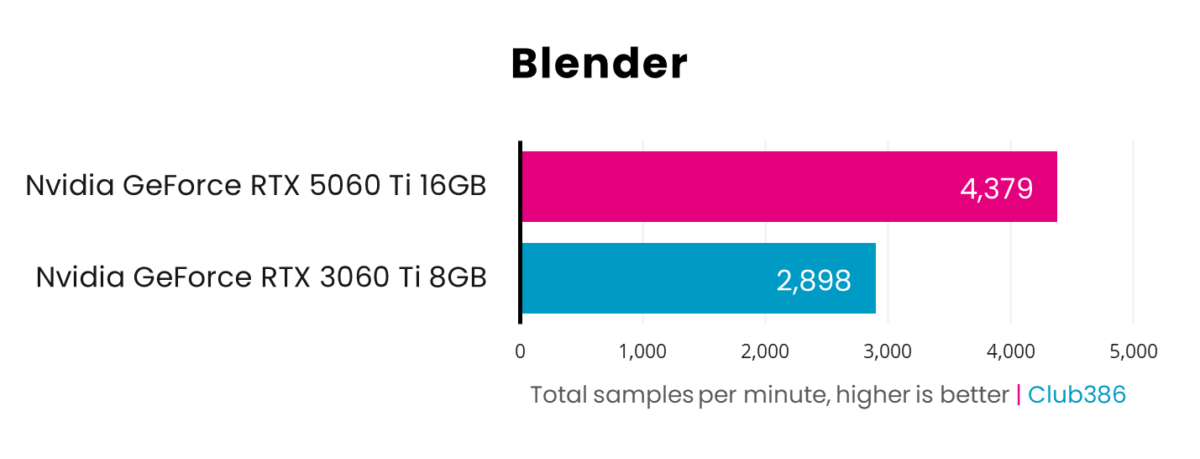
If you’re a 3D artist on a budget rocking RTX 3060 Ti, then upgrading to RTX 5060 Ti 16GB will massively improve your workflow. Sample counts are up an enormous 51% on the newer card.
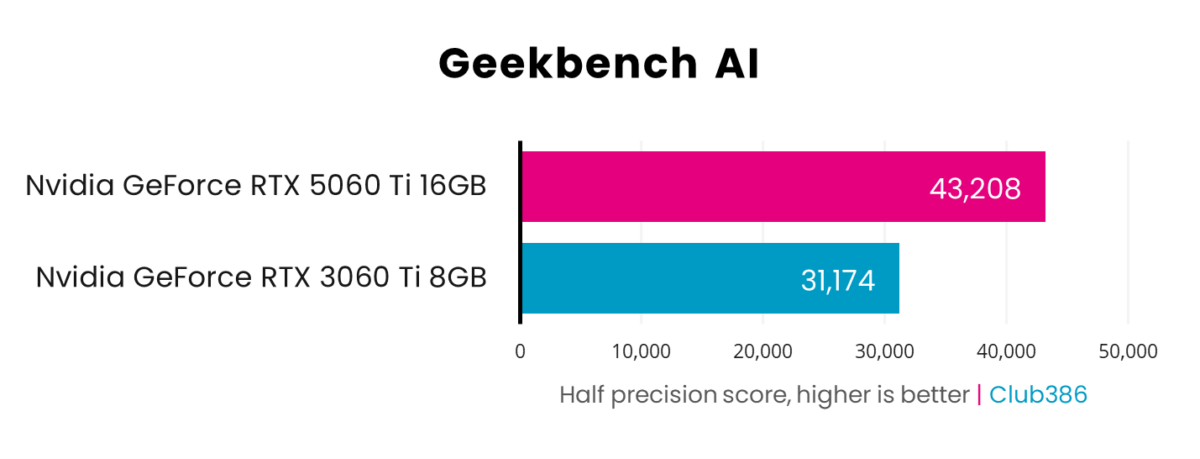
It should come as no surprise that RTX 5060 Ti clobbers RTX 3060 Ti when it comes to FP16 performance, in large part thanks to its fifth-gen Tensor cores. Testing their mettle in Geekbench AI sees the current generation contender enjoy a 39% advantage.
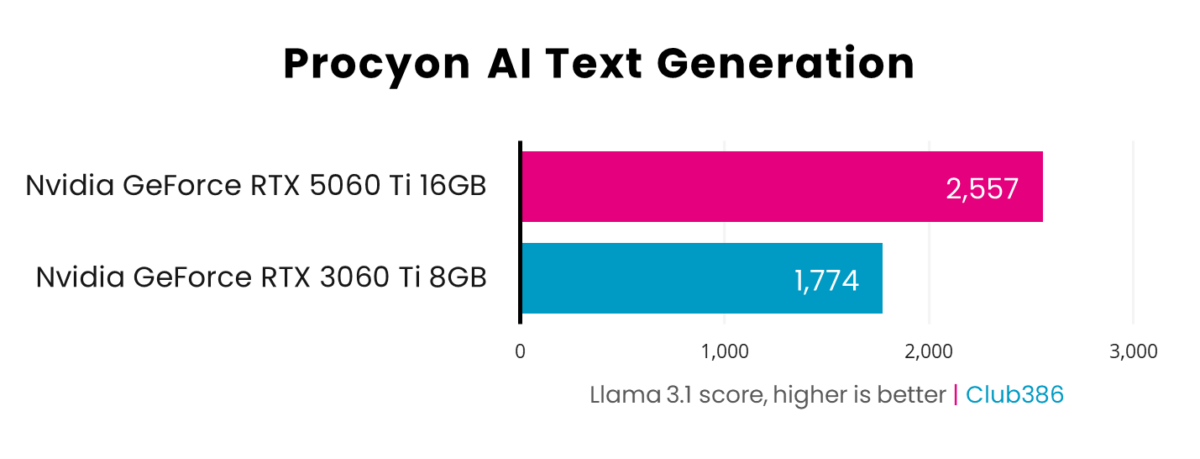
Superior AI chops walking hand-in-hand with a larger buffer nets RTX 5060 Ti wider LLM (Large Language Model) compatibility in addition to better performance overall. Running Llama 3.1 locally, it performs 44% the better of RTX 3060 Ti in the Procyon AI Text Generation benchmark.
Gaming
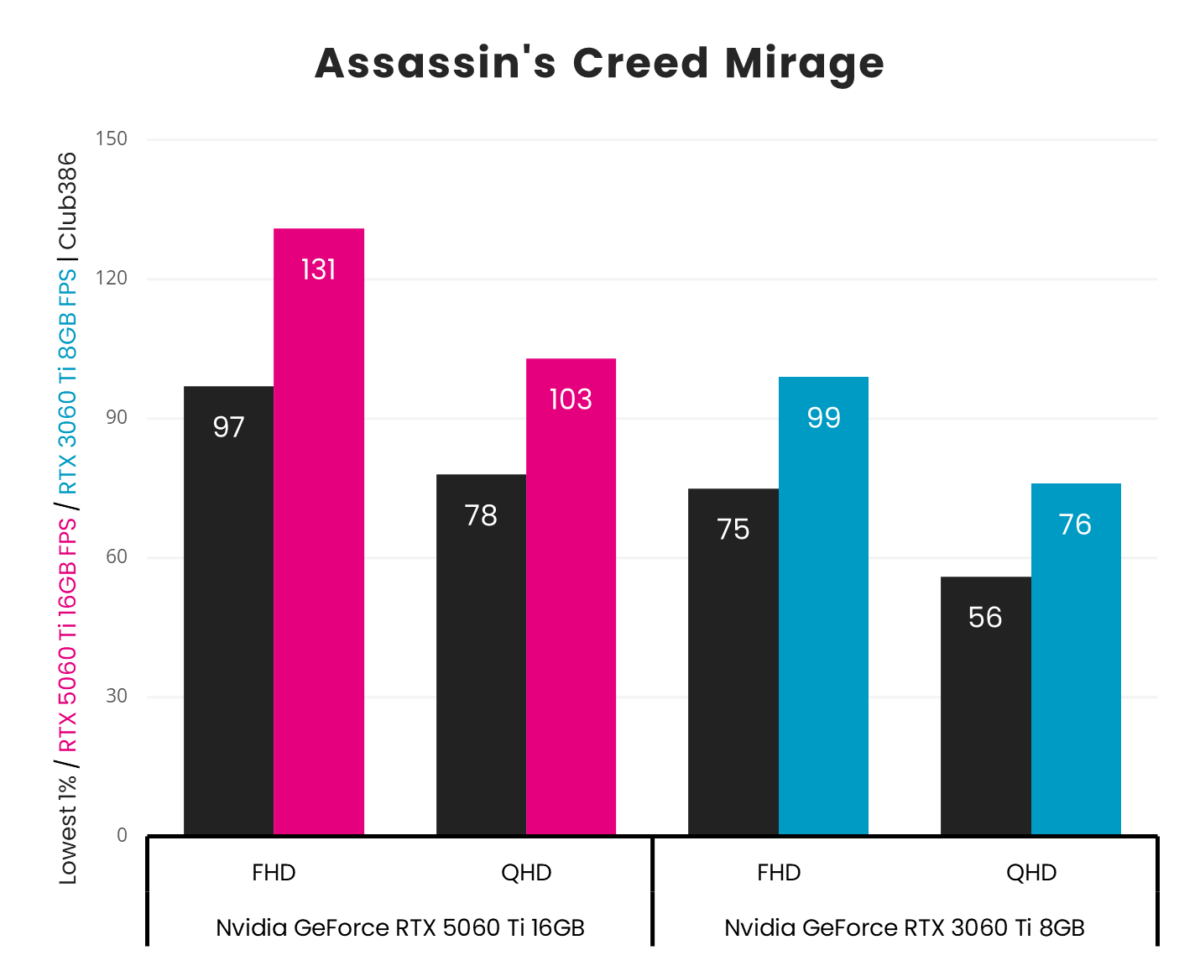
Frame rates in Assassin’s Creed Mirage reflect and even exceed the rasterised gains 3DMark promised. RTX 5060 Ti leaps ahead of RTX 3060 Ti by 32% at FHD and 36% at QHD, pushing north of 100fps at both resolutions while its predecessor falls short of the same feat.

Both RTX 5060 Ti and RTX 3060 Ti are surprisingly close in their Final Fantasy XIV: Dawntrail performance profiles, in that the generational gap isn’t quite so large at 14-19% across FHD and QHD. Minimum frame rates see a healthier increase, though, at 21-24%.
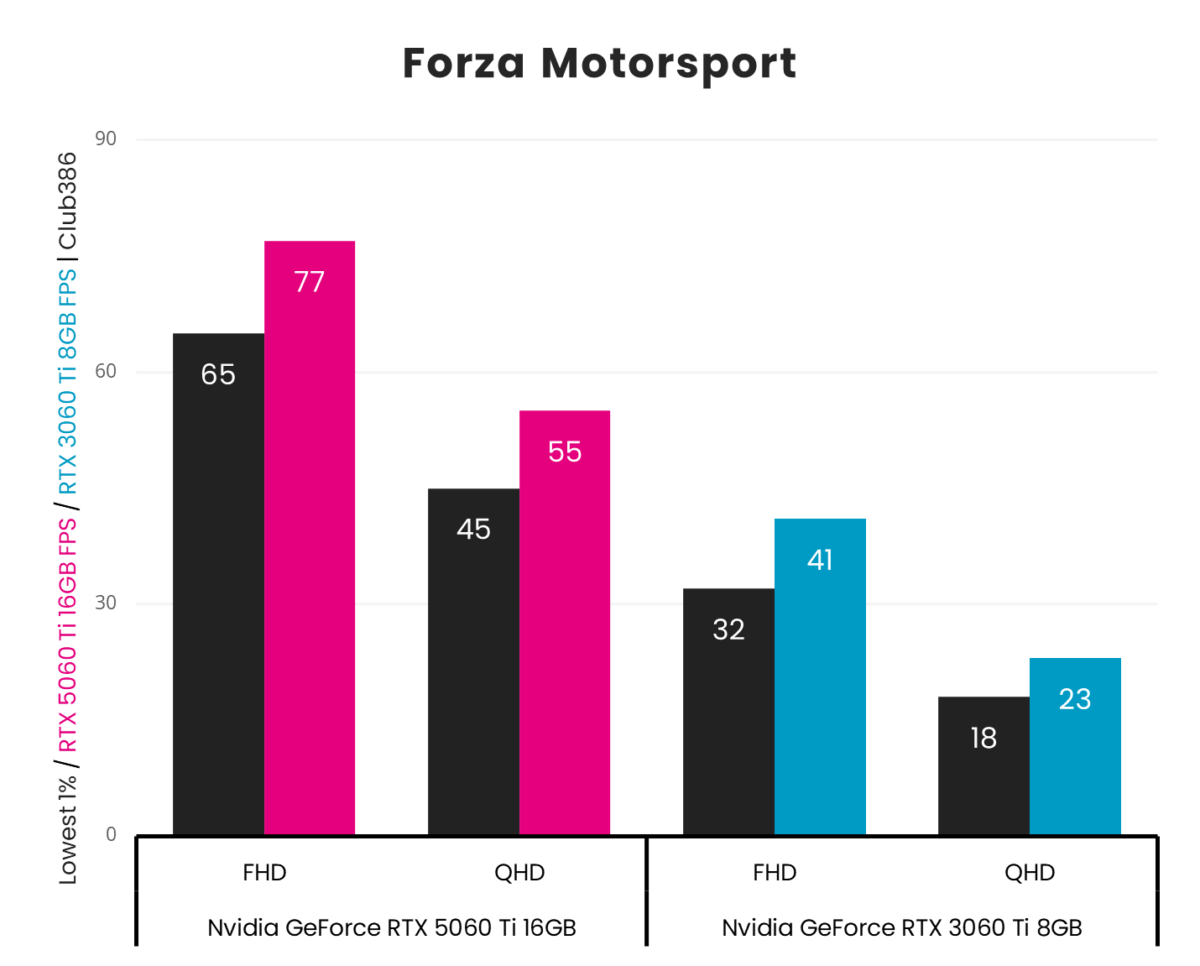
That’s no mistake, RTX 5060 Ti really is that much better at running Forza Motorsport than RTX 3060 Ti. Its vastly higher frame rates are in part due to its better RT cores but its 16GB buffer plays a key role too.
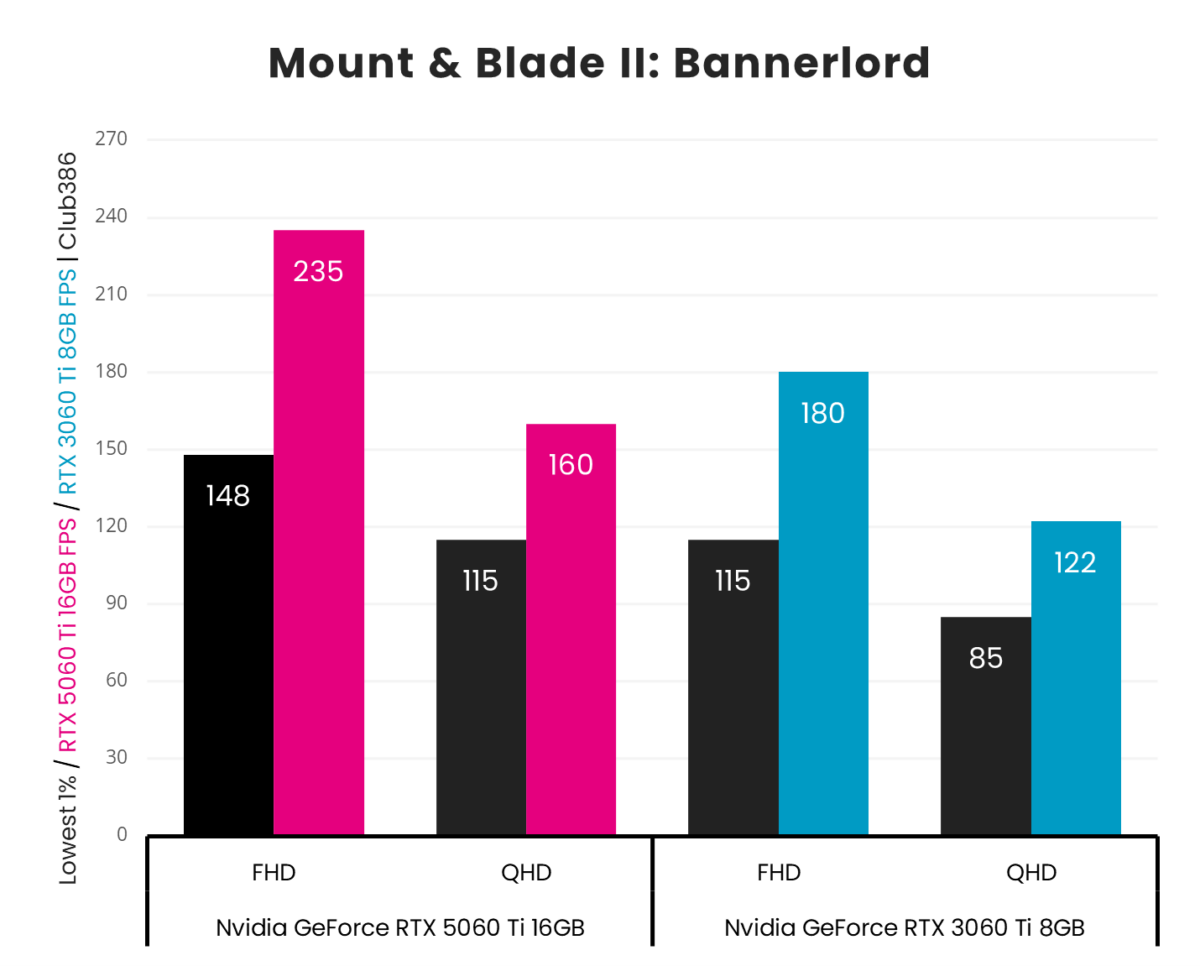
Mount & Blade II: Bannerlord provides plenty of space for both graphics cards to stretch their legs, but it’s clear that RTX 5060 Ti is in control of this battlefield. Regardless of resolution, it’s 31% ahead of RTX 3060 Ti.
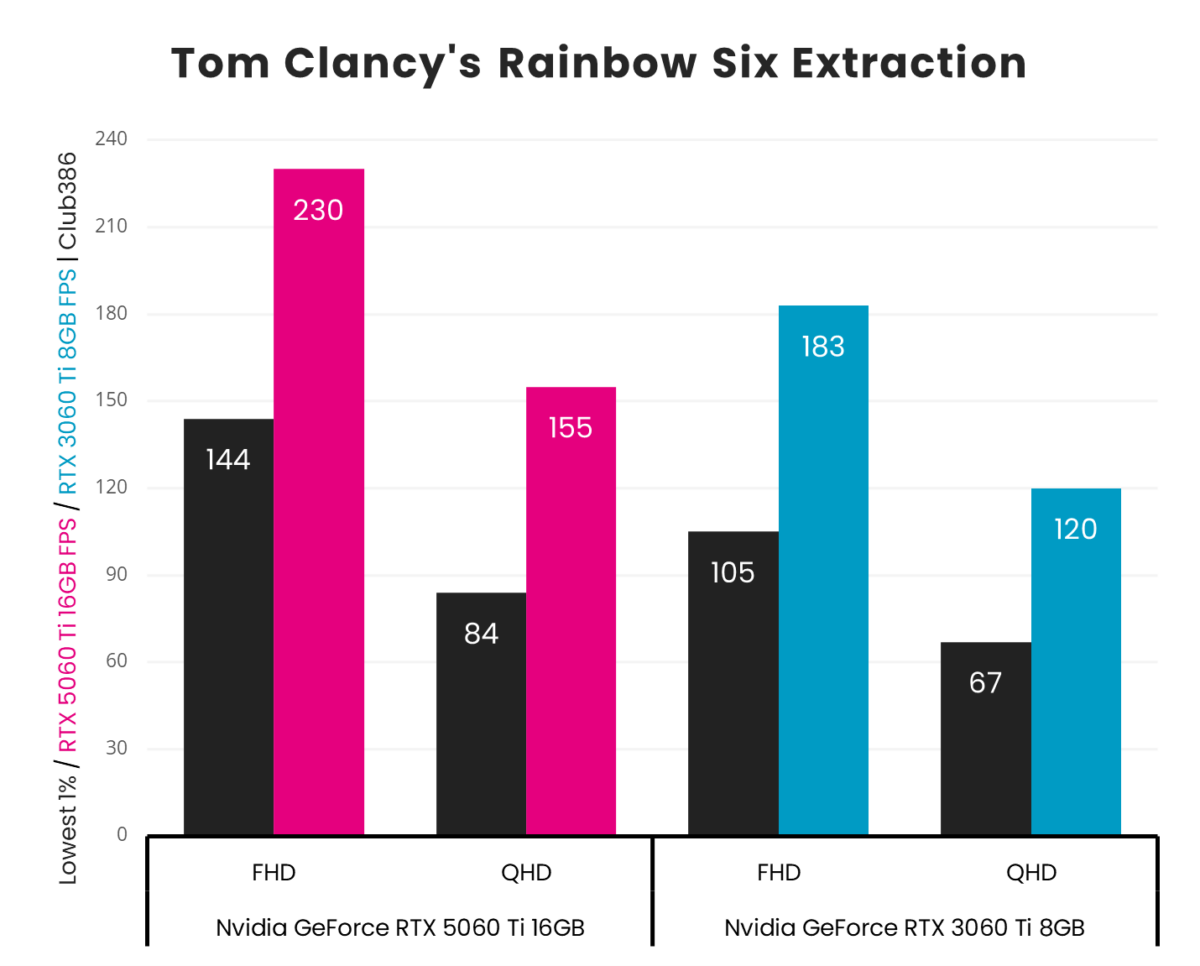
RTX 3060 Ti puts in a solid showing in Rainbow Six: Extraction but it can’t compete with the frame rates offered up by RTX 5060 Ti, as 183fps on the older card becomes 230fps on the new. While raw numbers aren’t quite as impressive at QHD on the surface, the percentile uplift is actually higher at 29% (vs. 26% at FHD).
DLSS
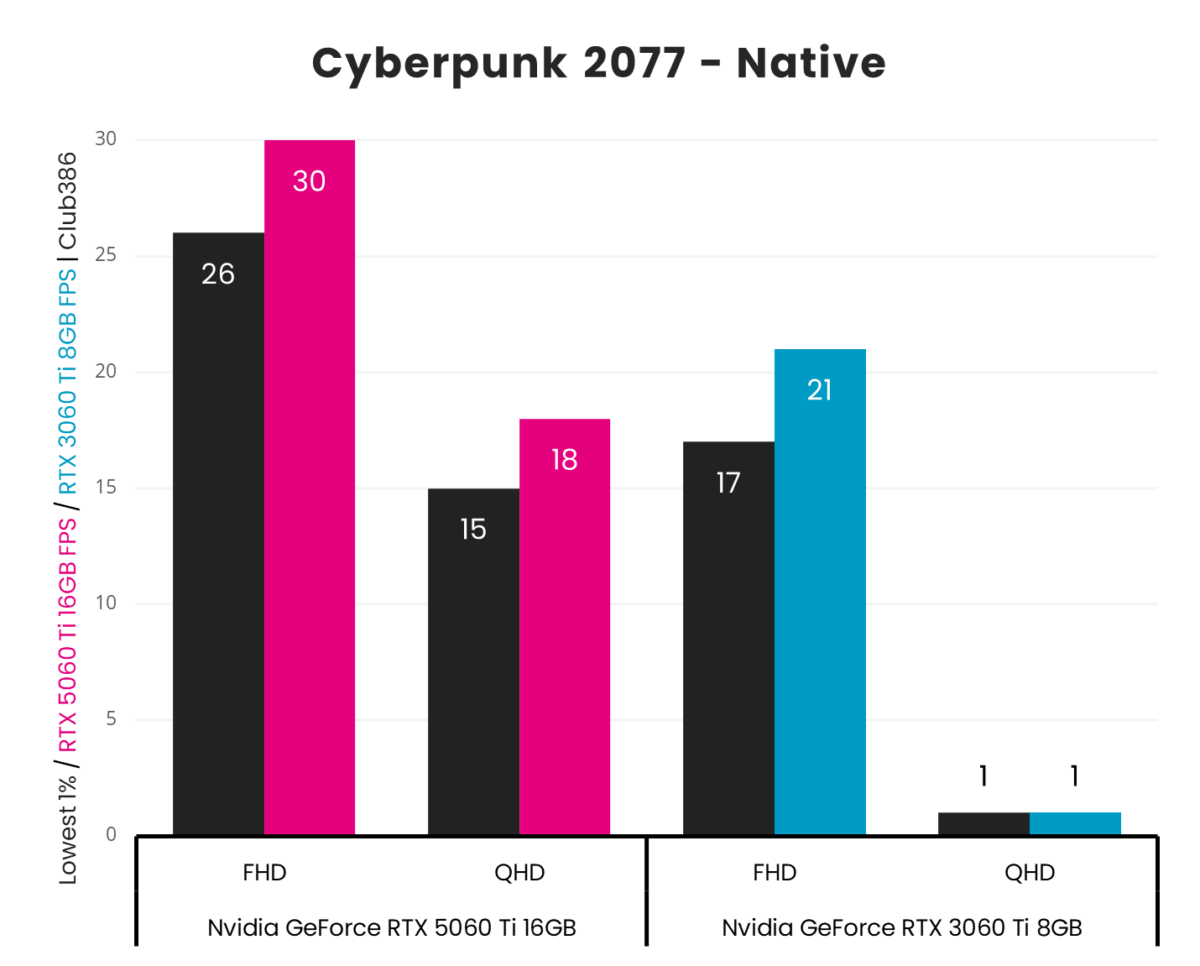
It’s time to open up each card’s bag of tricks and push them to their limits as we enable DLSS and venture into Night City in search of path traced pastures.
First, though, it’s important to establish baselines to understand how much DLSS is helping either card. Both cards struggle to overcome such lofty rendering requirements, but RTX 5060 Ti does manage a 30fps average at FHD. It buckles at QHD but not nearly as much as RTX 3060 Ti which runs painfully slow at 1fps.
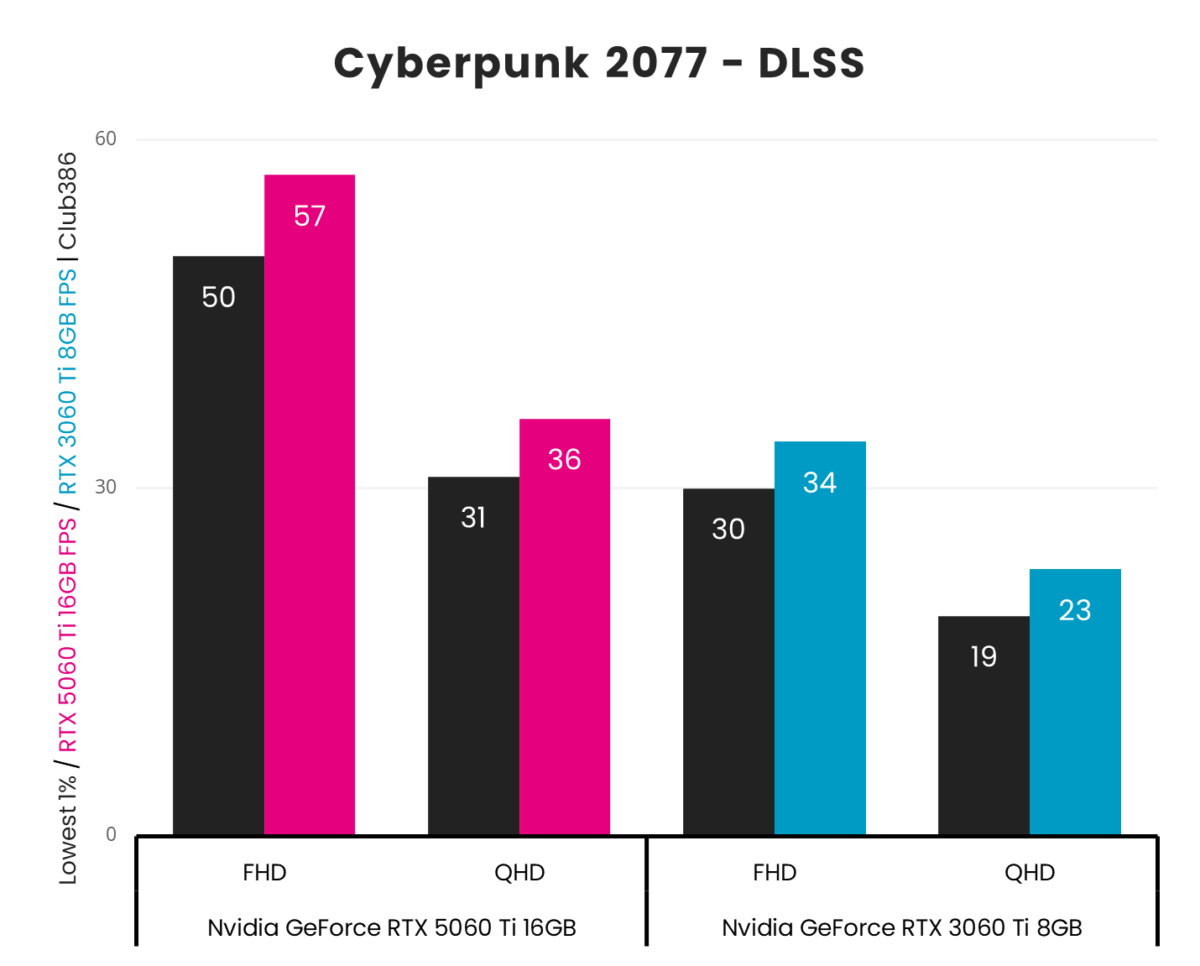
Turning on DLSS Super Resolution increases RTX 5060 Ti frame rates at QHD by double, from 18fps to 36fps, and FHD comes close too, from 30fps to 57fps. Sadly, RTX 3060 Ti doesn’t enjoy the same bump in performance at FHD but at least it isn’t running a literal slideshow at QHD now.
It’s important to note that RTX 5060 Ti can run Nvidia’s Transformer model for upscaling, improving image quality with minimal affect to performance. RTX 3060 Ti does support it but activating it comes with a more significant performance penalty, making it more difficult to reasonably use in place of the lower-quality Convolutional model.
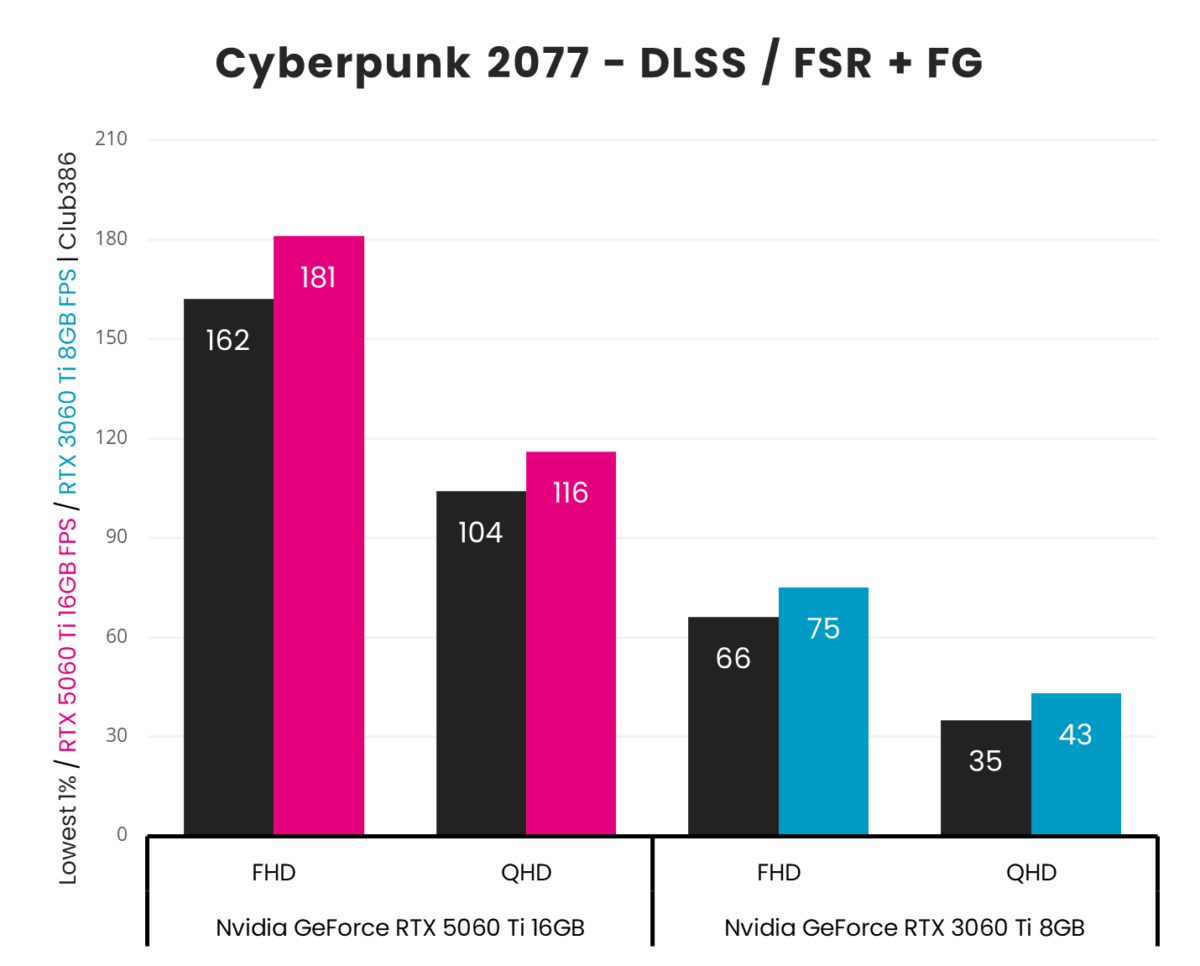
RTX 3060 Ti doesn’t support DLSS Frame Generation but it can swap to FSR Frame Generation. Unfortunately, its base frame rates simply aren’t high enough using either upscaler to warrant using frame generation resulting in high latency and a sluggish experience.
By contrast, RTX 5060 Ti is just a few frames short of that all-important 60fps base which a less-demanding DLSS Super Resolution preset (Balanced, Performance, etc.) will help remedy. All that’s left to do is toggle Multi Frame Generation and watch frame rates skyrocket to a whopping 180fps and enjoy the higher motion clarity.
Vitals
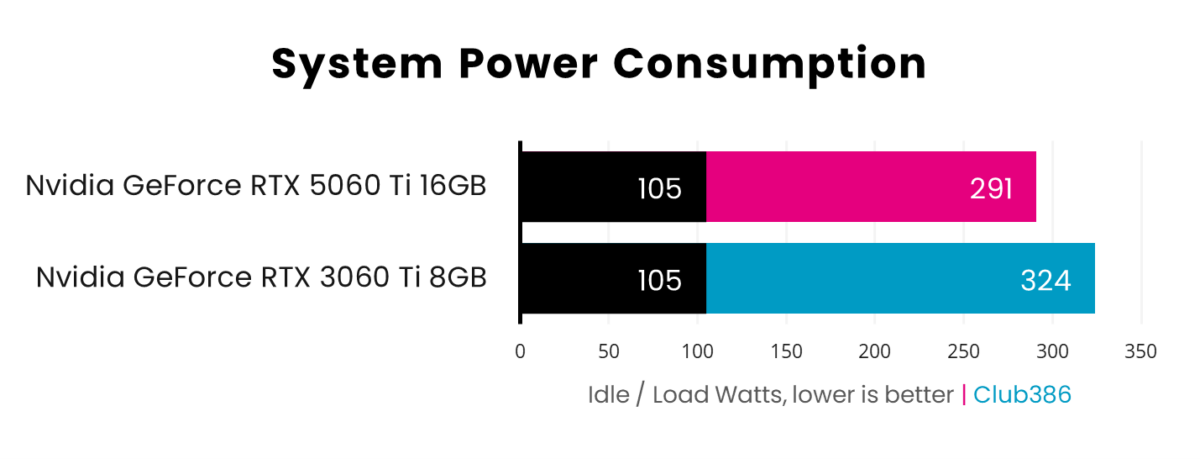
After a clean sweep in performance benchmarks, power consumption serves as RTX 5060 Ti’s a coup de grâce against RTX 3060 Ti. Not only does it run circles around its forebear, it does so while consuming 10% fewer watts under load.

Noise profiles will vary across coolers but Asus Prime RTX 5060 Ti is 6% quieter than RTX 3060 Ti Founders Edition when putting them to work.
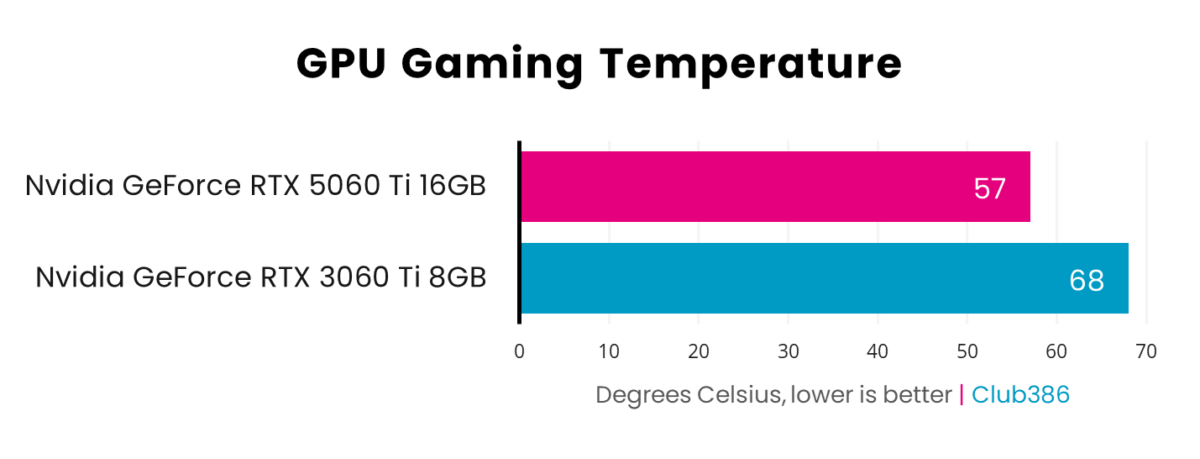
RTX 5060 Ti looks far cooler than RTX 3060 Ti as it secures its final victory, as its gaming temperatures are 16% lower.
Conclusion
Despite its lower theoretical specs in some areas, RTX 5060 Ti consistently outpaces its predecessor, particularly at 1080p and 1440p. The leap in RT performance is immediately apparent, especially when ray tracing and DLSS 4’s Multi Frame Generation are in play. Ampere, while groundbreaking in its day, simply can’t match the neural rendering and AI-assisted pipeline Nvidia’s newer cards are now capable of.
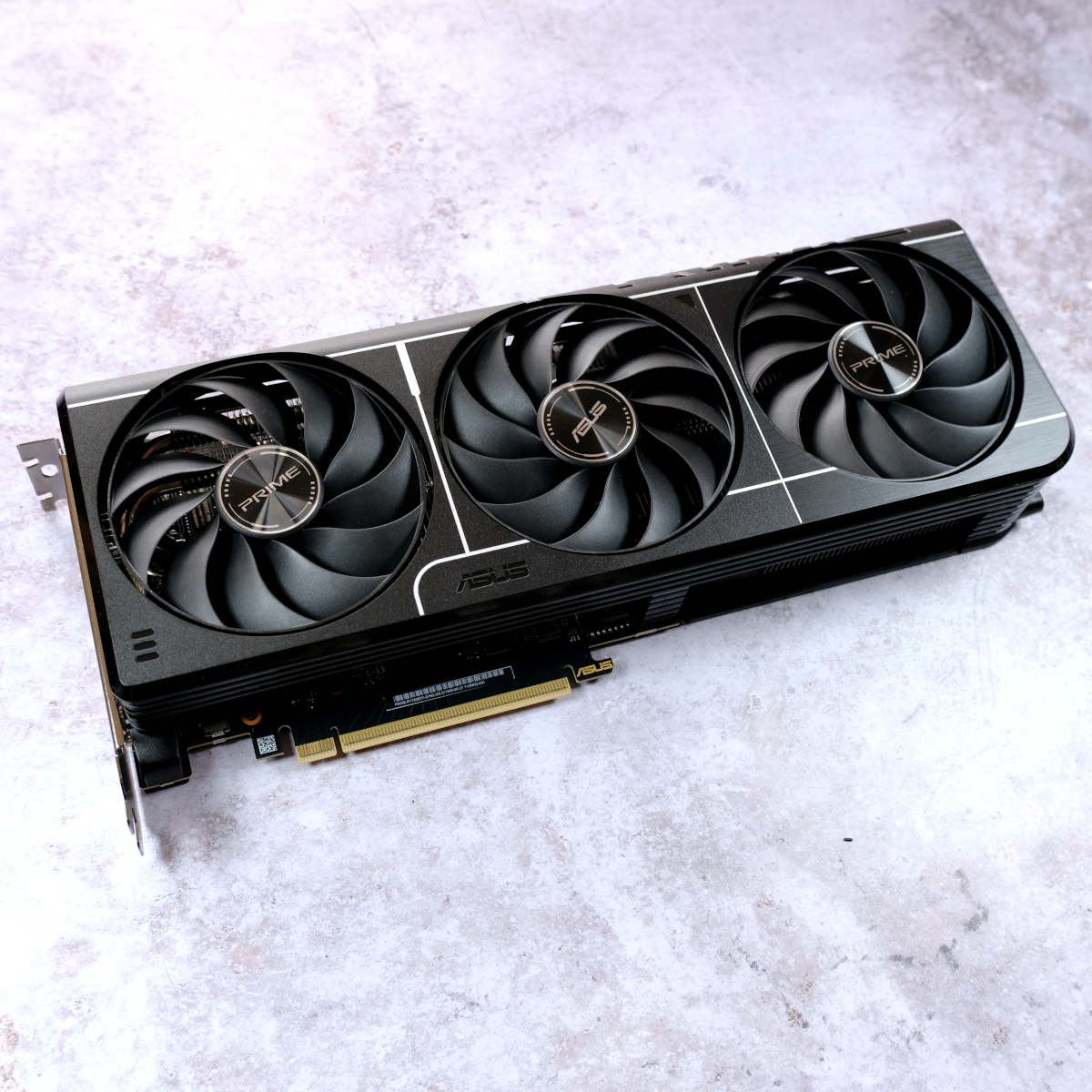
GeForce RTX 5060 Ti
“GeForce RTX 5060 Ti 16GB brings the power of Blackwell to the mainstream with solid results.” Read our review.
While it’s tempting to grab RTX 5060 Ti 8GB for $379 and undercut the launch price of RTX 3060 Ti ($399) by $20, the smarter play is to spend another $30 and grab RTX 5060 Ti 16GB for $429. That larger buffer will do wonders in some scenarios, as the likes of Forza Motorsport demonstrate beautifully. Ampere may still hold nostalgic appeal, but Blackwell begs the upgrade and won’t leave you disappointed.


